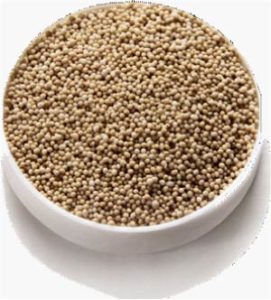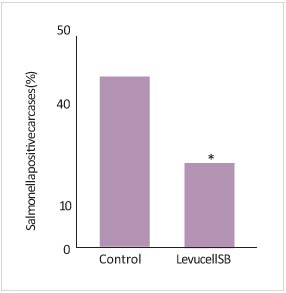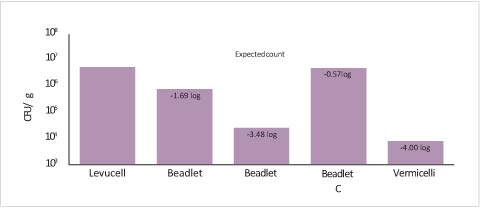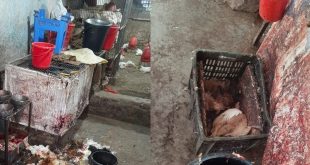 Soon after hatching, the chicken’s gastrointestinal tract becomes home to a rich and complex microbiota which plays a key role in the bird’s digestion and natural defences. In the post-antibiotic era, probiotics appear as one of the best documented approaches to help optimise performance and well-being through balancing this microbiota.
Soon after hatching, the chicken’s gastrointestinal tract becomes home to a rich and complex microbiota which plays a key role in the bird’s digestion and natural defences. In the post-antibiotic era, probiotics appear as one of the best documented approaches to help optimise performance and well-being through balancing this microbiota.
Most recently, the live yeast strain Saccharomyces cerevisiae boulardii CNCM I- 1079 has become the first and only feed additive authorised by the European Union authorities (EFSA) for the reduction of carcase contamination by Salmonella spp. in broiler chickens.
This represents a new and efficient tool to the poultry industry players that have to implement strict prevention procedure from farm to slaughterhouse and food processing steps. But beyond this novel ‘farm to fork’ approach to food safety, the probiotic yeast also brings good value to the poultry farmer through improved economic performance.

Food safety: The EFSA authorisation is based on an extensive research dossier compiling several trials with the live yeast S. c. boulardii CNCM I-1079 in commercial conditions. They show that this probiotic can help reduce the Salmonella spp. contamination on carcases of broiler chicken, and thus improve the quality and safety of poultry food products.
A recently communicated multi- analysis by Demey et al, compiles results of five studies from the scientific literature. In three of the studies, birds were subject to pathogen challenge (oral gavage with Salmonella spp.), two with natural contamination occurrence.
This analysis concluded with a significant reduction of the number of animals positive for salmonella carriage with the live yeast supplement (P<0.05) and of the number of carcases contaminated with the foodborne pathogen (P<0.05) (Fig. 1).
Moreover, the modes of action of this particular probiotic yeast have been extensively demonstrated in vivo and in other monogastrics species (swine).
It can be summarised in three main points:
˙Supporting a balanced intestinal microbiota.
˙Preserving intestinal integrity.
˙Reinforcing the host’s natural defences.
Enhancing performance and welfare in standard conditions : Various trials under different farming conditions confirm S. cerevisiae boulardii CNCM I-1079 benefits on broiler performance. A recent trial was performed in an experimental farm in 2018 over 35 days (internal data, Lallemand 2018).
The protocol recreated typical European farming conditions: 208 Ross PM3 mixed-sex broilers received a three-phase pelleted diet. Unfortunately, during the finisher phase, a viral challenge occurred for all animals (infectious bronchitis virus), and the overall mortality reached 14.4%. Interestingly, this allowed researchers to see the broilers fed the probiotic yeast better resisted the health challenge.

The total mortality was reduced by 42% with the supplement. This is mainly due to better resistance to the virus and the specific mortality linked to infectious bronchitis was reduced by 33% (Table 1). The overall zootechnical performance was improved. Until day 25, likely due to sanitary conditions, both groups exceeded the breed standards of performance. In the finisher phase, as a result of the viral challenge, economical feed conversion rate (FCR) worsened in both groups.

feed (a,b= p=0.1).
However, in the probiotic group, it was improved by as much as 34%, resulting in more than 7% improvement over the whole period. Final body weight was increased by 2.7% (+60g at d35).
Efficacy under intensive (AGP using) conditions : A trial conducted in the Philippines compared the effects of a feeding program including either S. c. boulardii CNCM I-1079 or an antibiotic growth promoter (enramycin) in 10,000 chickens.
Under these intensive rearing conditions, S.c. boulardii CNCM I-1079 reduced the mortality rate by 25% compared to enramycin – 4.89% vs. 6.56% with the antibiotic – and increased final body weight by 2% without damaging the FCR.
Overall, taking into account liveability and growth parameters, the European Performance Efficiency Factor was improved by 14 points in the S. c. boulardii CNCM I- 1079 group compared to AGP, meaning an +$0.03/kg of live weight)
Formulation : The live yeast S. cerevisiae boulardii CNCM I-1079 is formulated with the TITAN patented microencapsulation technology for live yeast. This technology enables the probiotic to withstand most conditions encountered in broiler feed pelleting processes (heat, pressure, humidity) and interaction with other chemical compounds used in feed manufacture.
A study, performed by an independent and recognised institute (IFF institute, Germany) has shown that, among various yeast product forms, TITAN offers the higher resistance to pelleting process (at 85˚C, 1T/h) and storage in feed for up to three months (Fig. 2).
Conclusion : In conclusion, the live yeast S. c. boulardii CNCM I-1079 represents a new tool for broiler meat production that offers advantages for the whole food chain, from bird welfare and performance for the farmer, to meat product safety at the slaughterhouse.
- by Amandine Cabot, Sylvie Roquefeuil and Jean-Baptiste Soula, Lallemand Animal Nutrition, France. www.lallemandanimalnutrition.com
- References are available from the author on request
 Agrinews24 কৃষির সাথে, কৃষকের পাশে
Agrinews24 কৃষির সাথে, কৃষকের পাশে





















